Accounting for Corporations
VerifiedAdded on 2023/01/16
|11
|3263
|54
AI Summary
This document provides an overview of accounting for corporations, focusing on the equity composition, debt structure, and fixed assets of Wesfarmers Ltd. It discusses the company's activities, equity capital, share price, debt structure, and key elements of fixed assets. The document also covers intangible assets and the impairment policy followed by the company.
Contribute Materials
Your contribution can guide someone’s learning journey. Share your
documents today.
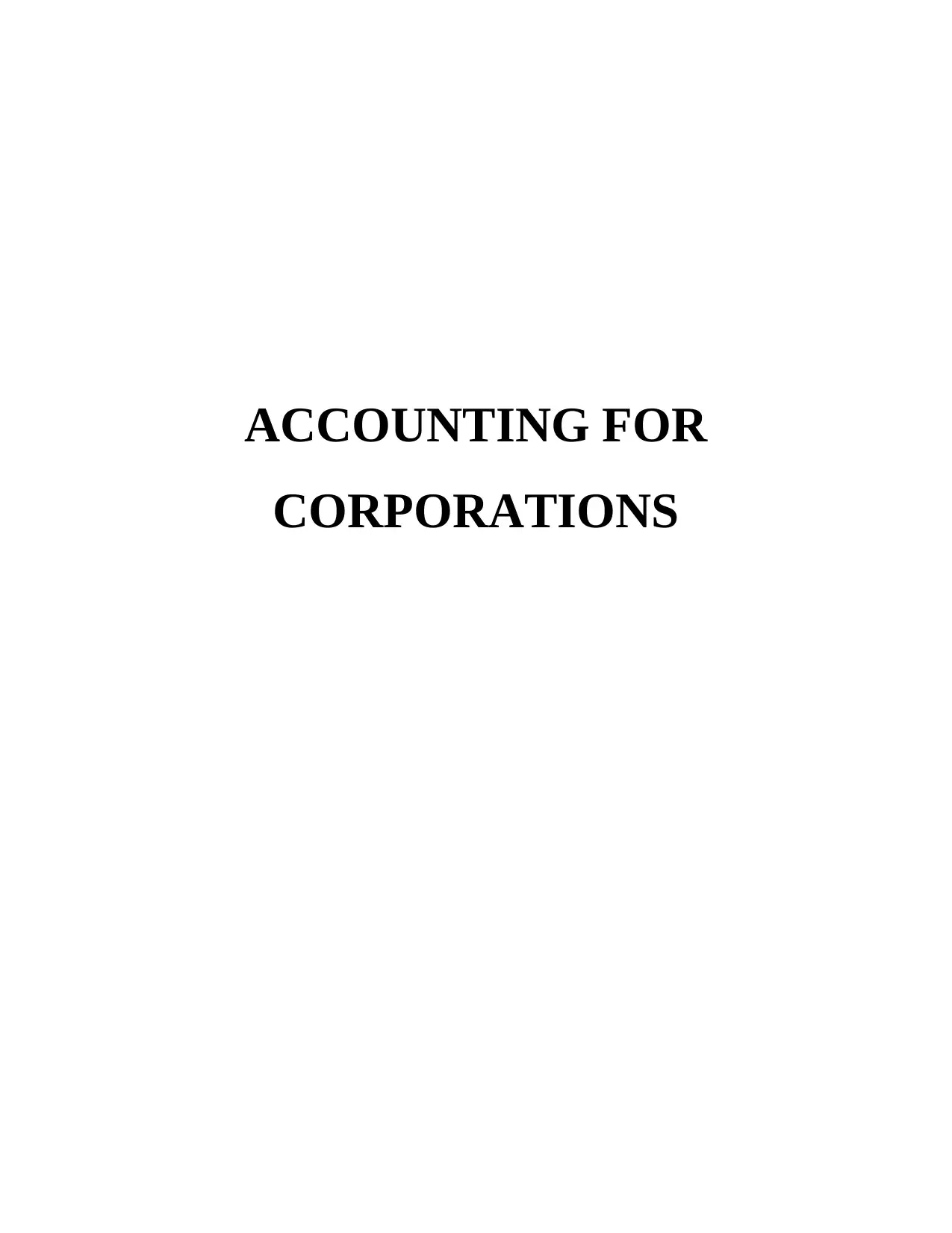
ACCOUNTING FOR
CORPORATIONS
CORPORATIONS
Secure Best Marks with AI Grader
Need help grading? Try our AI Grader for instant feedback on your assignments.

TABLE OF CONTENTS
INTRODUCTION...........................................................................................................................1
MAIN BODY...................................................................................................................................1
Company and its Activities..........................................................................................................1
Equity Composition of Company................................................................................................2
Relationship of share price and share capital of company...........................................................3
Share price after one calendar month and its possible reasons. ..................................................4
Debt structure and external financing sources of company. .......................................................5
Key element in Fixed assets categories.......................................................................................6
Intangible assets and impairment policy followed. .....................................................................7
Financial operations of Company during the financial year........................................................7
CONCLUSION................................................................................................................................8
REFERENCES................................................................................................................................9
INTRODUCTION...........................................................................................................................1
MAIN BODY...................................................................................................................................1
Company and its Activities..........................................................................................................1
Equity Composition of Company................................................................................................2
Relationship of share price and share capital of company...........................................................3
Share price after one calendar month and its possible reasons. ..................................................4
Debt structure and external financing sources of company. .......................................................5
Key element in Fixed assets categories.......................................................................................6
Intangible assets and impairment policy followed. .....................................................................7
Financial operations of Company during the financial year........................................................7
CONCLUSION................................................................................................................................8
REFERENCES................................................................................................................................9

INTRODUCTION
Accounting plays an important role in every organization to record, summarize and
present the accounting information in form of financial reports. Corporate structure is governed
by the set standards. The report is based on the annual and corporate structure of Wesfarmers
Ltd.
MAIN BODY
Executive Report Wesfarmers Limited
Company and its Activities
Since from its origin in 1914 as Western Australian farmers' cooperative, Wesfarmers
had grown into one of the largest listed company of Australia. It has headquarters in Perth,
Western Australia and is involved in diverse businesses (Wesfarmers, 2019). Wesfarmers is
predominant in Australian and New Zealand retails, chemical, fertilizers, coal mining and the
safety products. Divisions of Wesfarmers
Home Improvement and the Office Supplies
Division is made of Bunnings Warehouse, retailer of the home improvements and of outdoor
living products, in servicing home and the commercial customers of Australia & New Zealand
(Collison and et.al., 2016). Officeworks, supplier and retailer of the office product for home,
education and business in Australia.
Department Stores
Few years back it announced restructure of department store busieness into single division called
Department Stores, where each brand is operating independently.
Kmart
It is discount department stores retailer in New Zealand and Australia and provides retail
automotive repairs, services and tyres.
Target
It is also discount retail department store in Australia with more than 305 stores. In 2014, value
of the Target was written down by $680 million due to decline in profit.
Industrials
Organisational restructure of 2015 clustered three businesses Energy, Chemical and Fertilizers;
Resources ; and Industrial & Safety in single Industrial division.
Chemicals, Energy and Fertilizers
1
Accounting plays an important role in every organization to record, summarize and
present the accounting information in form of financial reports. Corporate structure is governed
by the set standards. The report is based on the annual and corporate structure of Wesfarmers
Ltd.
MAIN BODY
Executive Report Wesfarmers Limited
Company and its Activities
Since from its origin in 1914 as Western Australian farmers' cooperative, Wesfarmers
had grown into one of the largest listed company of Australia. It has headquarters in Perth,
Western Australia and is involved in diverse businesses (Wesfarmers, 2019). Wesfarmers is
predominant in Australian and New Zealand retails, chemical, fertilizers, coal mining and the
safety products. Divisions of Wesfarmers
Home Improvement and the Office Supplies
Division is made of Bunnings Warehouse, retailer of the home improvements and of outdoor
living products, in servicing home and the commercial customers of Australia & New Zealand
(Collison and et.al., 2016). Officeworks, supplier and retailer of the office product for home,
education and business in Australia.
Department Stores
Few years back it announced restructure of department store busieness into single division called
Department Stores, where each brand is operating independently.
Kmart
It is discount department stores retailer in New Zealand and Australia and provides retail
automotive repairs, services and tyres.
Target
It is also discount retail department store in Australia with more than 305 stores. In 2014, value
of the Target was written down by $680 million due to decline in profit.
Industrials
Organisational restructure of 2015 clustered three businesses Energy, Chemical and Fertilizers;
Resources ; and Industrial & Safety in single Industrial division.
Chemicals, Energy and Fertilizers
1
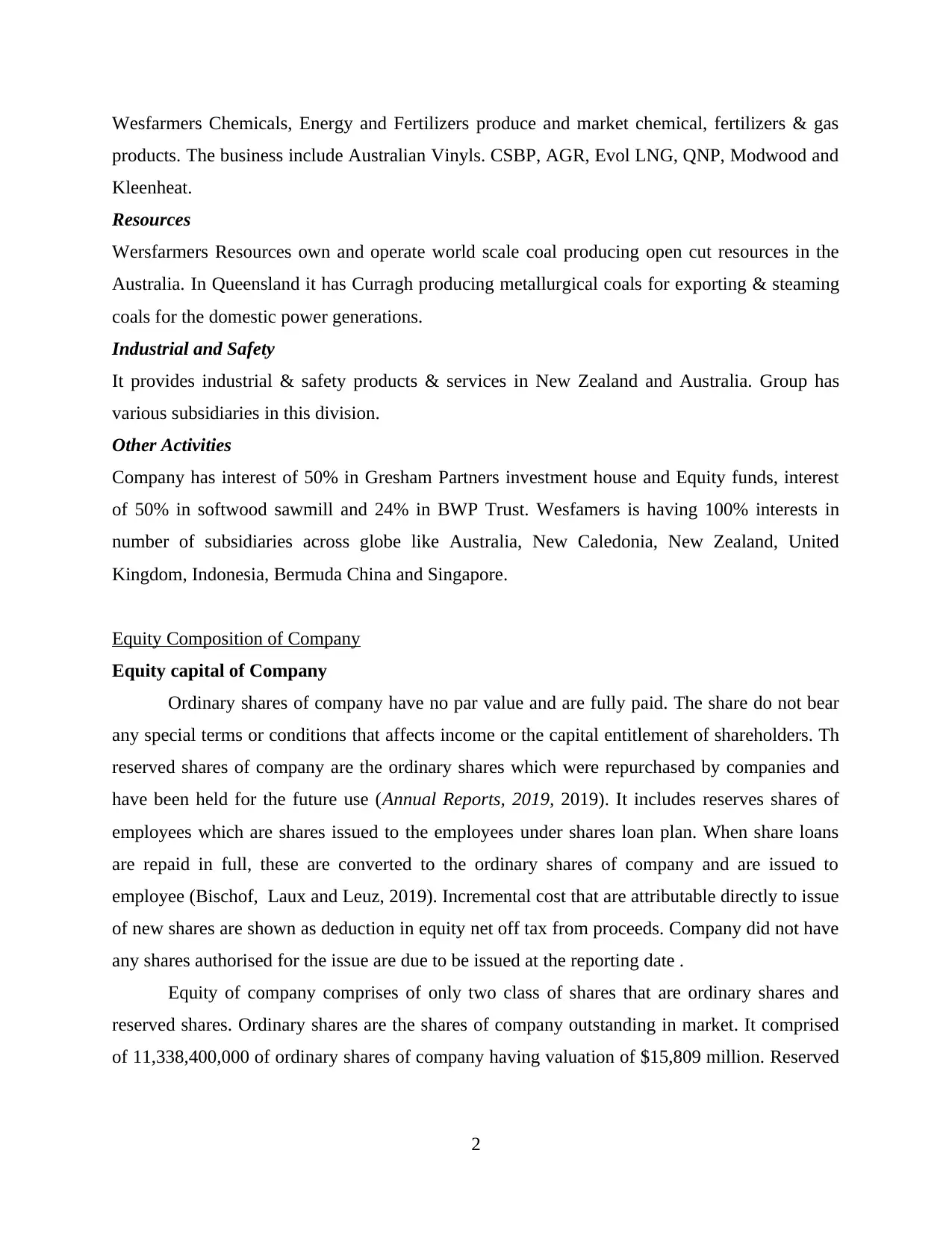
Wesfarmers Chemicals, Energy and Fertilizers produce and market chemical, fertilizers & gas
products. The business include Australian Vinyls. CSBP, AGR, Evol LNG, QNP, Modwood and
Kleenheat.
Resources
Wersfarmers Resources own and operate world scale coal producing open cut resources in the
Australia. In Queensland it has Curragh producing metallurgical coals for exporting & steaming
coals for the domestic power generations.
Industrial and Safety
It provides industrial & safety products & services in New Zealand and Australia. Group has
various subsidiaries in this division.
Other Activities
Company has interest of 50% in Gresham Partners investment house and Equity funds, interest
of 50% in softwood sawmill and 24% in BWP Trust. Wesfamers is having 100% interests in
number of subsidiaries across globe like Australia, New Caledonia, New Zealand, United
Kingdom, Indonesia, Bermuda China and Singapore.
Equity Composition of Company
Equity capital of Company
Ordinary shares of company have no par value and are fully paid. The share do not bear
any special terms or conditions that affects income or the capital entitlement of shareholders. Th
reserved shares of company are the ordinary shares which were repurchased by companies and
have been held for the future use (Annual Reports, 2019, 2019). It includes reserves shares of
employees which are shares issued to the employees under shares loan plan. When share loans
are repaid in full, these are converted to the ordinary shares of company and are issued to
employee (Bischof, Laux and Leuz, 2019). Incremental cost that are attributable directly to issue
of new shares are shown as deduction in equity net off tax from proceeds. Company did not have
any shares authorised for the issue are due to be issued at the reporting date .
Equity of company comprises of only two class of shares that are ordinary shares and
reserved shares. Ordinary shares are the shares of company outstanding in market. It comprised
of 11,338,400,000 of ordinary shares of company having valuation of $15,809 million. Reserved
2
products. The business include Australian Vinyls. CSBP, AGR, Evol LNG, QNP, Modwood and
Kleenheat.
Resources
Wersfarmers Resources own and operate world scale coal producing open cut resources in the
Australia. In Queensland it has Curragh producing metallurgical coals for exporting & steaming
coals for the domestic power generations.
Industrial and Safety
It provides industrial & safety products & services in New Zealand and Australia. Group has
various subsidiaries in this division.
Other Activities
Company has interest of 50% in Gresham Partners investment house and Equity funds, interest
of 50% in softwood sawmill and 24% in BWP Trust. Wesfamers is having 100% interests in
number of subsidiaries across globe like Australia, New Caledonia, New Zealand, United
Kingdom, Indonesia, Bermuda China and Singapore.
Equity Composition of Company
Equity capital of Company
Ordinary shares of company have no par value and are fully paid. The share do not bear
any special terms or conditions that affects income or the capital entitlement of shareholders. Th
reserved shares of company are the ordinary shares which were repurchased by companies and
have been held for the future use (Annual Reports, 2019, 2019). It includes reserves shares of
employees which are shares issued to the employees under shares loan plan. When share loans
are repaid in full, these are converted to the ordinary shares of company and are issued to
employee (Bischof, Laux and Leuz, 2019). Incremental cost that are attributable directly to issue
of new shares are shown as deduction in equity net off tax from proceeds. Company did not have
any shares authorised for the issue are due to be issued at the reporting date .
Equity of company comprises of only two class of shares that are ordinary shares and
reserved shares. Ordinary shares are the shares of company outstanding in market. It comprised
of 11,338,400,000 of ordinary shares of company having valuation of $15,809 million. Reserved
2
Secure Best Marks with AI Grader
Need help grading? Try our AI Grader for instant feedback on your assignments.
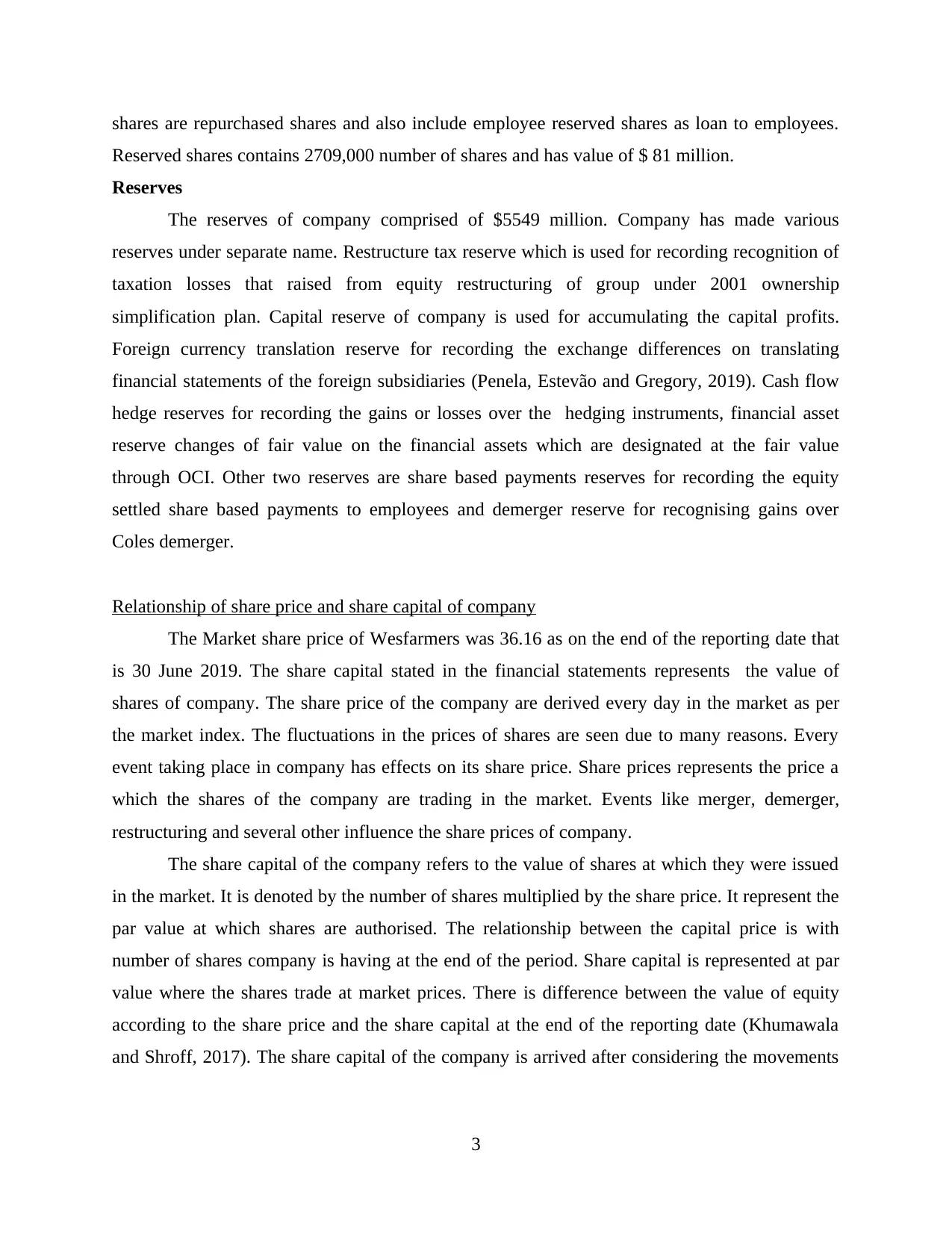
shares are repurchased shares and also include employee reserved shares as loan to employees.
Reserved shares contains 2709,000 number of shares and has value of $ 81 million.
Reserves
The reserves of company comprised of $5549 million. Company has made various
reserves under separate name. Restructure tax reserve which is used for recording recognition of
taxation losses that raised from equity restructuring of group under 2001 ownership
simplification plan. Capital reserve of company is used for accumulating the capital profits.
Foreign currency translation reserve for recording the exchange differences on translating
financial statements of the foreign subsidiaries (Penela, Estevão and Gregory, 2019). Cash flow
hedge reserves for recording the gains or losses over the hedging instruments, financial asset
reserve changes of fair value on the financial assets which are designated at the fair value
through OCI. Other two reserves are share based payments reserves for recording the equity
settled share based payments to employees and demerger reserve for recognising gains over
Coles demerger.
Relationship of share price and share capital of company
The Market share price of Wesfarmers was 36.16 as on the end of the reporting date that
is 30 June 2019. The share capital stated in the financial statements represents the value of
shares of company. The share price of the company are derived every day in the market as per
the market index. The fluctuations in the prices of shares are seen due to many reasons. Every
event taking place in company has effects on its share price. Share prices represents the price a
which the shares of the company are trading in the market. Events like merger, demerger,
restructuring and several other influence the share prices of company.
The share capital of the company refers to the value of shares at which they were issued
in the market. It is denoted by the number of shares multiplied by the share price. It represent the
par value at which shares are authorised. The relationship between the capital price is with
number of shares company is having at the end of the period. Share capital is represented at par
value where the shares trade at market prices. There is difference between the value of equity
according to the share price and the share capital at the end of the reporting date (Khumawala
and Shroff, 2017). The share capital of the company is arrived after considering the movements
3
Reserved shares contains 2709,000 number of shares and has value of $ 81 million.
Reserves
The reserves of company comprised of $5549 million. Company has made various
reserves under separate name. Restructure tax reserve which is used for recording recognition of
taxation losses that raised from equity restructuring of group under 2001 ownership
simplification plan. Capital reserve of company is used for accumulating the capital profits.
Foreign currency translation reserve for recording the exchange differences on translating
financial statements of the foreign subsidiaries (Penela, Estevão and Gregory, 2019). Cash flow
hedge reserves for recording the gains or losses over the hedging instruments, financial asset
reserve changes of fair value on the financial assets which are designated at the fair value
through OCI. Other two reserves are share based payments reserves for recording the equity
settled share based payments to employees and demerger reserve for recognising gains over
Coles demerger.
Relationship of share price and share capital of company
The Market share price of Wesfarmers was 36.16 as on the end of the reporting date that
is 30 June 2019. The share capital stated in the financial statements represents the value of
shares of company. The share price of the company are derived every day in the market as per
the market index. The fluctuations in the prices of shares are seen due to many reasons. Every
event taking place in company has effects on its share price. Share prices represents the price a
which the shares of the company are trading in the market. Events like merger, demerger,
restructuring and several other influence the share prices of company.
The share capital of the company refers to the value of shares at which they were issued
in the market. It is denoted by the number of shares multiplied by the share price. It represent the
par value at which shares are authorised. The relationship between the capital price is with
number of shares company is having at the end of the period. Share capital is represented at par
value where the shares trade at market prices. There is difference between the value of equity
according to the share price and the share capital at the end of the reporting date (Khumawala
and Shroff, 2017). The share capital of the company is arrived after considering the movements
3
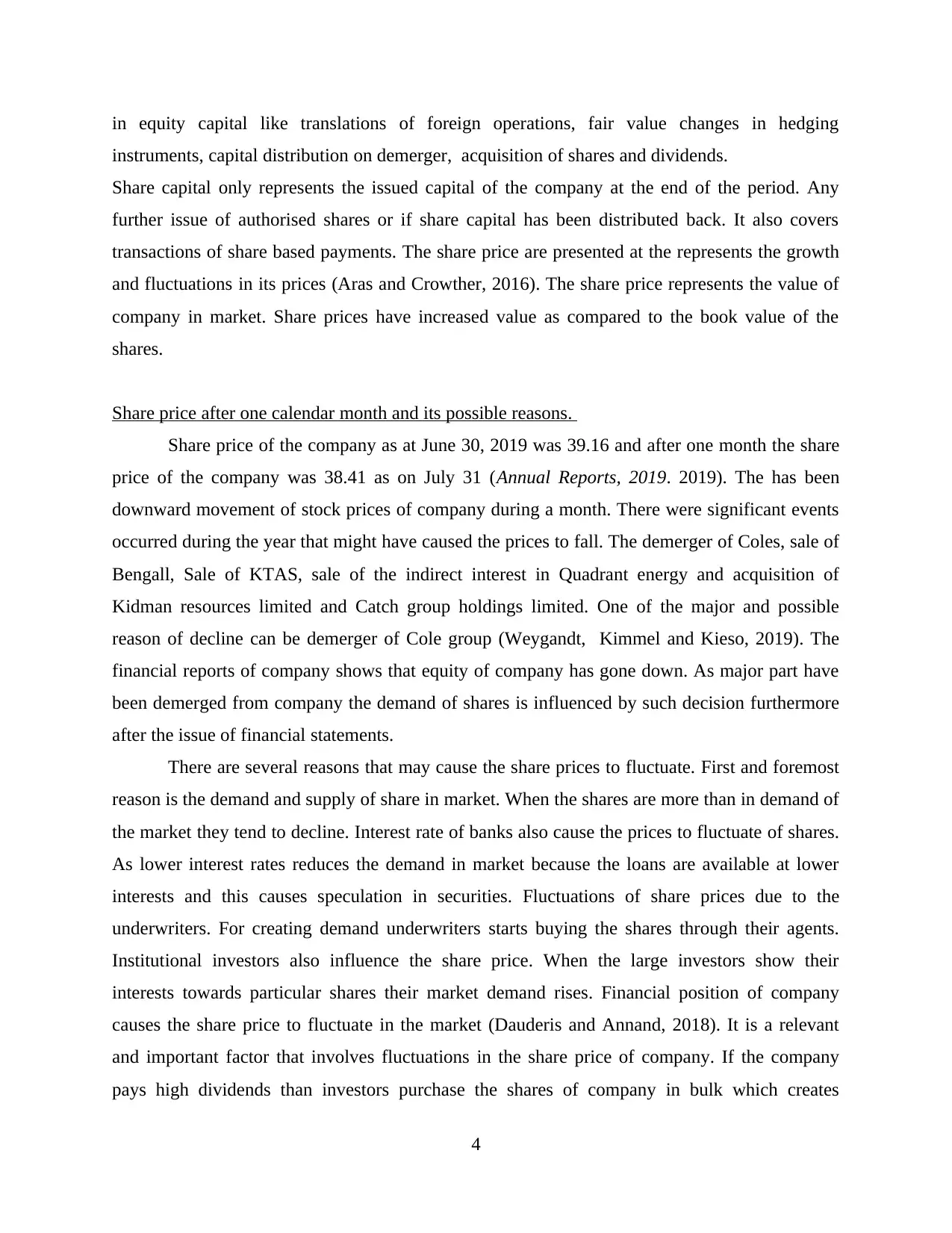
in equity capital like translations of foreign operations, fair value changes in hedging
instruments, capital distribution on demerger, acquisition of shares and dividends.
Share capital only represents the issued capital of the company at the end of the period. Any
further issue of authorised shares or if share capital has been distributed back. It also covers
transactions of share based payments. The share price are presented at the represents the growth
and fluctuations in its prices (Aras and Crowther, 2016). The share price represents the value of
company in market. Share prices have increased value as compared to the book value of the
shares.
Share price after one calendar month and its possible reasons.
Share price of the company as at June 30, 2019 was 39.16 and after one month the share
price of the company was 38.41 as on July 31 (Annual Reports, 2019. 2019). The has been
downward movement of stock prices of company during a month. There were significant events
occurred during the year that might have caused the prices to fall. The demerger of Coles, sale of
Bengall, Sale of KTAS, sale of the indirect interest in Quadrant energy and acquisition of
Kidman resources limited and Catch group holdings limited. One of the major and possible
reason of decline can be demerger of Cole group (Weygandt, Kimmel and Kieso, 2019). The
financial reports of company shows that equity of company has gone down. As major part have
been demerged from company the demand of shares is influenced by such decision furthermore
after the issue of financial statements.
There are several reasons that may cause the share prices to fluctuate. First and foremost
reason is the demand and supply of share in market. When the shares are more than in demand of
the market they tend to decline. Interest rate of banks also cause the prices to fluctuate of shares.
As lower interest rates reduces the demand in market because the loans are available at lower
interests and this causes speculation in securities. Fluctuations of share prices due to the
underwriters. For creating demand underwriters starts buying the shares through their agents.
Institutional investors also influence the share price. When the large investors show their
interests towards particular shares their market demand rises. Financial position of company
causes the share price to fluctuate in the market (Dauderis and Annand, 2018). It is a relevant
and important factor that involves fluctuations in the share price of company. If the company
pays high dividends than investors purchase the shares of company in bulk which creates
4
instruments, capital distribution on demerger, acquisition of shares and dividends.
Share capital only represents the issued capital of the company at the end of the period. Any
further issue of authorised shares or if share capital has been distributed back. It also covers
transactions of share based payments. The share price are presented at the represents the growth
and fluctuations in its prices (Aras and Crowther, 2016). The share price represents the value of
company in market. Share prices have increased value as compared to the book value of the
shares.
Share price after one calendar month and its possible reasons.
Share price of the company as at June 30, 2019 was 39.16 and after one month the share
price of the company was 38.41 as on July 31 (Annual Reports, 2019. 2019). The has been
downward movement of stock prices of company during a month. There were significant events
occurred during the year that might have caused the prices to fall. The demerger of Coles, sale of
Bengall, Sale of KTAS, sale of the indirect interest in Quadrant energy and acquisition of
Kidman resources limited and Catch group holdings limited. One of the major and possible
reason of decline can be demerger of Cole group (Weygandt, Kimmel and Kieso, 2019). The
financial reports of company shows that equity of company has gone down. As major part have
been demerged from company the demand of shares is influenced by such decision furthermore
after the issue of financial statements.
There are several reasons that may cause the share prices to fluctuate. First and foremost
reason is the demand and supply of share in market. When the shares are more than in demand of
the market they tend to decline. Interest rate of banks also cause the prices to fluctuate of shares.
As lower interest rates reduces the demand in market because the loans are available at lower
interests and this causes speculation in securities. Fluctuations of share prices due to the
underwriters. For creating demand underwriters starts buying the shares through their agents.
Institutional investors also influence the share price. When the large investors show their
interests towards particular shares their market demand rises. Financial position of company
causes the share price to fluctuate in the market (Dauderis and Annand, 2018). It is a relevant
and important factor that involves fluctuations in the share price of company. If the company
pays high dividends than investors purchase the shares of company in bulk which creates
4
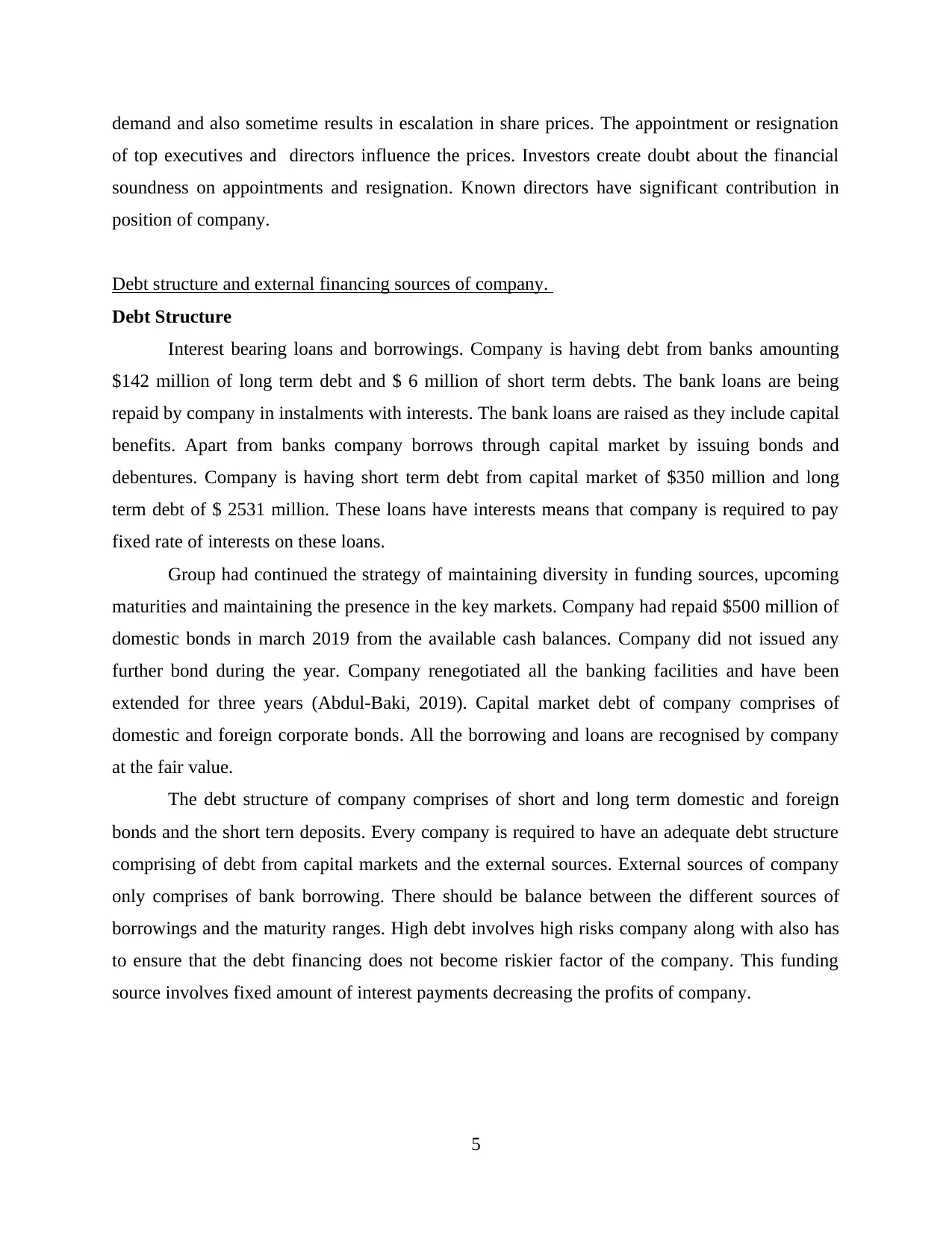
demand and also sometime results in escalation in share prices. The appointment or resignation
of top executives and directors influence the prices. Investors create doubt about the financial
soundness on appointments and resignation. Known directors have significant contribution in
position of company.
Debt structure and external financing sources of company.
Debt Structure
Interest bearing loans and borrowings. Company is having debt from banks amounting
$142 million of long term debt and $ 6 million of short term debts. The bank loans are being
repaid by company in instalments with interests. The bank loans are raised as they include capital
benefits. Apart from banks company borrows through capital market by issuing bonds and
debentures. Company is having short term debt from capital market of $350 million and long
term debt of $ 2531 million. These loans have interests means that company is required to pay
fixed rate of interests on these loans.
Group had continued the strategy of maintaining diversity in funding sources, upcoming
maturities and maintaining the presence in the key markets. Company had repaid $500 million of
domestic bonds in march 2019 from the available cash balances. Company did not issued any
further bond during the year. Company renegotiated all the banking facilities and have been
extended for three years (Abdul-Baki, 2019). Capital market debt of company comprises of
domestic and foreign corporate bonds. All the borrowing and loans are recognised by company
at the fair value.
The debt structure of company comprises of short and long term domestic and foreign
bonds and the short tern deposits. Every company is required to have an adequate debt structure
comprising of debt from capital markets and the external sources. External sources of company
only comprises of bank borrowing. There should be balance between the different sources of
borrowings and the maturity ranges. High debt involves high risks company along with also has
to ensure that the debt financing does not become riskier factor of the company. This funding
source involves fixed amount of interest payments decreasing the profits of company.
5
of top executives and directors influence the prices. Investors create doubt about the financial
soundness on appointments and resignation. Known directors have significant contribution in
position of company.
Debt structure and external financing sources of company.
Debt Structure
Interest bearing loans and borrowings. Company is having debt from banks amounting
$142 million of long term debt and $ 6 million of short term debts. The bank loans are being
repaid by company in instalments with interests. The bank loans are raised as they include capital
benefits. Apart from banks company borrows through capital market by issuing bonds and
debentures. Company is having short term debt from capital market of $350 million and long
term debt of $ 2531 million. These loans have interests means that company is required to pay
fixed rate of interests on these loans.
Group had continued the strategy of maintaining diversity in funding sources, upcoming
maturities and maintaining the presence in the key markets. Company had repaid $500 million of
domestic bonds in march 2019 from the available cash balances. Company did not issued any
further bond during the year. Company renegotiated all the banking facilities and have been
extended for three years (Abdul-Baki, 2019). Capital market debt of company comprises of
domestic and foreign corporate bonds. All the borrowing and loans are recognised by company
at the fair value.
The debt structure of company comprises of short and long term domestic and foreign
bonds and the short tern deposits. Every company is required to have an adequate debt structure
comprising of debt from capital markets and the external sources. External sources of company
only comprises of bank borrowing. There should be balance between the different sources of
borrowings and the maturity ranges. High debt involves high risks company along with also has
to ensure that the debt financing does not become riskier factor of the company. This funding
source involves fixed amount of interest payments decreasing the profits of company.
5
Paraphrase This Document
Need a fresh take? Get an instant paraphrase of this document with our AI Paraphraser
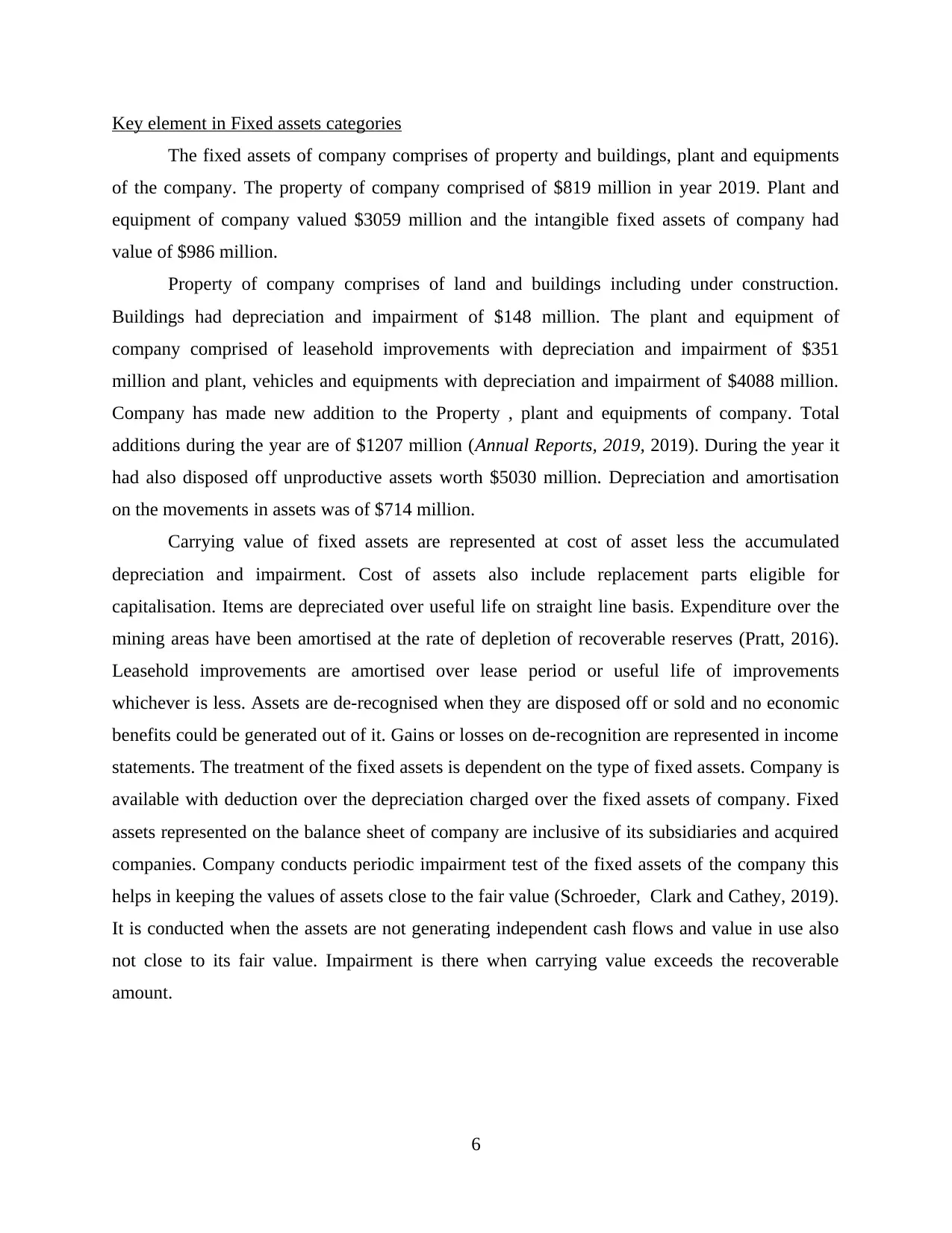
Key element in Fixed assets categories
The fixed assets of company comprises of property and buildings, plant and equipments
of the company. The property of company comprised of $819 million in year 2019. Plant and
equipment of company valued $3059 million and the intangible fixed assets of company had
value of $986 million.
Property of company comprises of land and buildings including under construction.
Buildings had depreciation and impairment of $148 million. The plant and equipment of
company comprised of leasehold improvements with depreciation and impairment of $351
million and plant, vehicles and equipments with depreciation and impairment of $4088 million.
Company has made new addition to the Property , plant and equipments of company. Total
additions during the year are of $1207 million (Annual Reports, 2019, 2019). During the year it
had also disposed off unproductive assets worth $5030 million. Depreciation and amortisation
on the movements in assets was of $714 million.
Carrying value of fixed assets are represented at cost of asset less the accumulated
depreciation and impairment. Cost of assets also include replacement parts eligible for
capitalisation. Items are depreciated over useful life on straight line basis. Expenditure over the
mining areas have been amortised at the rate of depletion of recoverable reserves (Pratt, 2016).
Leasehold improvements are amortised over lease period or useful life of improvements
whichever is less. Assets are de-recognised when they are disposed off or sold and no economic
benefits could be generated out of it. Gains or losses on de-recognition are represented in income
statements. The treatment of the fixed assets is dependent on the type of fixed assets. Company is
available with deduction over the depreciation charged over the fixed assets of company. Fixed
assets represented on the balance sheet of company are inclusive of its subsidiaries and acquired
companies. Company conducts periodic impairment test of the fixed assets of the company this
helps in keeping the values of assets close to the fair value (Schroeder, Clark and Cathey, 2019).
It is conducted when the assets are not generating independent cash flows and value in use also
not close to its fair value. Impairment is there when carrying value exceeds the recoverable
amount.
6
The fixed assets of company comprises of property and buildings, plant and equipments
of the company. The property of company comprised of $819 million in year 2019. Plant and
equipment of company valued $3059 million and the intangible fixed assets of company had
value of $986 million.
Property of company comprises of land and buildings including under construction.
Buildings had depreciation and impairment of $148 million. The plant and equipment of
company comprised of leasehold improvements with depreciation and impairment of $351
million and plant, vehicles and equipments with depreciation and impairment of $4088 million.
Company has made new addition to the Property , plant and equipments of company. Total
additions during the year are of $1207 million (Annual Reports, 2019, 2019). During the year it
had also disposed off unproductive assets worth $5030 million. Depreciation and amortisation
on the movements in assets was of $714 million.
Carrying value of fixed assets are represented at cost of asset less the accumulated
depreciation and impairment. Cost of assets also include replacement parts eligible for
capitalisation. Items are depreciated over useful life on straight line basis. Expenditure over the
mining areas have been amortised at the rate of depletion of recoverable reserves (Pratt, 2016).
Leasehold improvements are amortised over lease period or useful life of improvements
whichever is less. Assets are de-recognised when they are disposed off or sold and no economic
benefits could be generated out of it. Gains or losses on de-recognition are represented in income
statements. The treatment of the fixed assets is dependent on the type of fixed assets. Company is
available with deduction over the depreciation charged over the fixed assets of company. Fixed
assets represented on the balance sheet of company are inclusive of its subsidiaries and acquired
companies. Company conducts periodic impairment test of the fixed assets of the company this
helps in keeping the values of assets close to the fair value (Schroeder, Clark and Cathey, 2019).
It is conducted when the assets are not generating independent cash flows and value in use also
not close to its fair value. Impairment is there when carrying value exceeds the recoverable
amount.
6
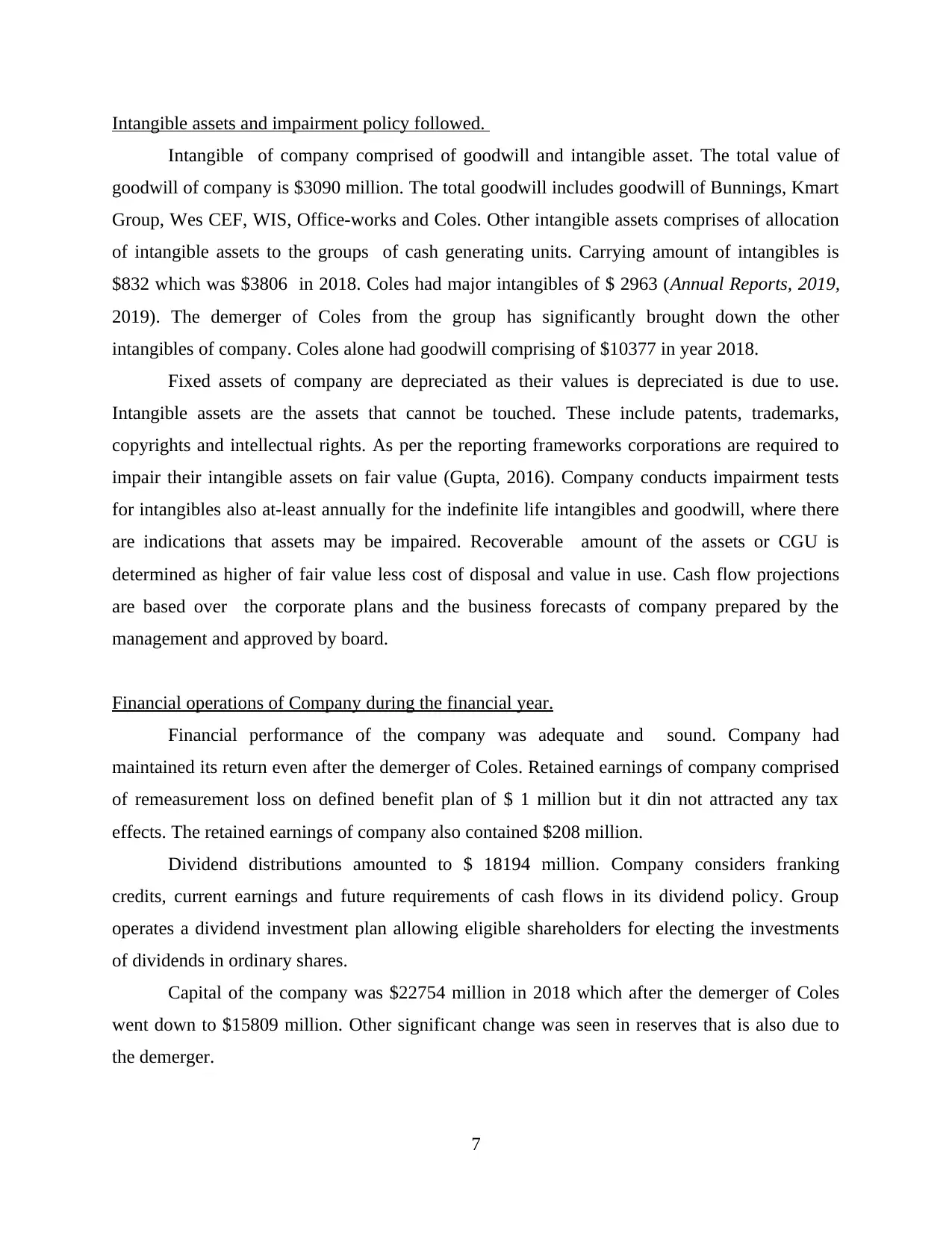
Intangible assets and impairment policy followed.
Intangible of company comprised of goodwill and intangible asset. The total value of
goodwill of company is $3090 million. The total goodwill includes goodwill of Bunnings, Kmart
Group, Wes CEF, WIS, Office-works and Coles. Other intangible assets comprises of allocation
of intangible assets to the groups of cash generating units. Carrying amount of intangibles is
$832 which was $3806 in 2018. Coles had major intangibles of $ 2963 (Annual Reports, 2019,
2019). The demerger of Coles from the group has significantly brought down the other
intangibles of company. Coles alone had goodwill comprising of $10377 in year 2018.
Fixed assets of company are depreciated as their values is depreciated is due to use.
Intangible assets are the assets that cannot be touched. These include patents, trademarks,
copyrights and intellectual rights. As per the reporting frameworks corporations are required to
impair their intangible assets on fair value (Gupta, 2016). Company conducts impairment tests
for intangibles also at-least annually for the indefinite life intangibles and goodwill, where there
are indications that assets may be impaired. Recoverable amount of the assets or CGU is
determined as higher of fair value less cost of disposal and value in use. Cash flow projections
are based over the corporate plans and the business forecasts of company prepared by the
management and approved by board.
Financial operations of Company during the financial year.
Financial performance of the company was adequate and sound. Company had
maintained its return even after the demerger of Coles. Retained earnings of company comprised
of remeasurement loss on defined benefit plan of $ 1 million but it din not attracted any tax
effects. The retained earnings of company also contained $208 million.
Dividend distributions amounted to $ 18194 million. Company considers franking
credits, current earnings and future requirements of cash flows in its dividend policy. Group
operates a dividend investment plan allowing eligible shareholders for electing the investments
of dividends in ordinary shares.
Capital of the company was $22754 million in 2018 which after the demerger of Coles
went down to $15809 million. Other significant change was seen in reserves that is also due to
the demerger.
7
Intangible of company comprised of goodwill and intangible asset. The total value of
goodwill of company is $3090 million. The total goodwill includes goodwill of Bunnings, Kmart
Group, Wes CEF, WIS, Office-works and Coles. Other intangible assets comprises of allocation
of intangible assets to the groups of cash generating units. Carrying amount of intangibles is
$832 which was $3806 in 2018. Coles had major intangibles of $ 2963 (Annual Reports, 2019,
2019). The demerger of Coles from the group has significantly brought down the other
intangibles of company. Coles alone had goodwill comprising of $10377 in year 2018.
Fixed assets of company are depreciated as their values is depreciated is due to use.
Intangible assets are the assets that cannot be touched. These include patents, trademarks,
copyrights and intellectual rights. As per the reporting frameworks corporations are required to
impair their intangible assets on fair value (Gupta, 2016). Company conducts impairment tests
for intangibles also at-least annually for the indefinite life intangibles and goodwill, where there
are indications that assets may be impaired. Recoverable amount of the assets or CGU is
determined as higher of fair value less cost of disposal and value in use. Cash flow projections
are based over the corporate plans and the business forecasts of company prepared by the
management and approved by board.
Financial operations of Company during the financial year.
Financial performance of the company was adequate and sound. Company had
maintained its return even after the demerger of Coles. Retained earnings of company comprised
of remeasurement loss on defined benefit plan of $ 1 million but it din not attracted any tax
effects. The retained earnings of company also contained $208 million.
Dividend distributions amounted to $ 18194 million. Company considers franking
credits, current earnings and future requirements of cash flows in its dividend policy. Group
operates a dividend investment plan allowing eligible shareholders for electing the investments
of dividends in ordinary shares.
Capital of the company was $22754 million in 2018 which after the demerger of Coles
went down to $15809 million. Other significant change was seen in reserves that is also due to
the demerger.
7

CONCLUSION
The above research shows that financial statements of the company provide all the
relevant information that is required for analysing the financial health and position of company.
It is essential for the analysts and experts to have the ability to understand and identify h reasons
behind change in financial figures. The events and transaction have impact over both the
financial statements and share prices of company.
8
The above research shows that financial statements of the company provide all the
relevant information that is required for analysing the financial health and position of company.
It is essential for the analysts and experts to have the ability to understand and identify h reasons
behind change in financial figures. The events and transaction have impact over both the
financial statements and share prices of company.
8
Secure Best Marks with AI Grader
Need help grading? Try our AI Grader for instant feedback on your assignments.
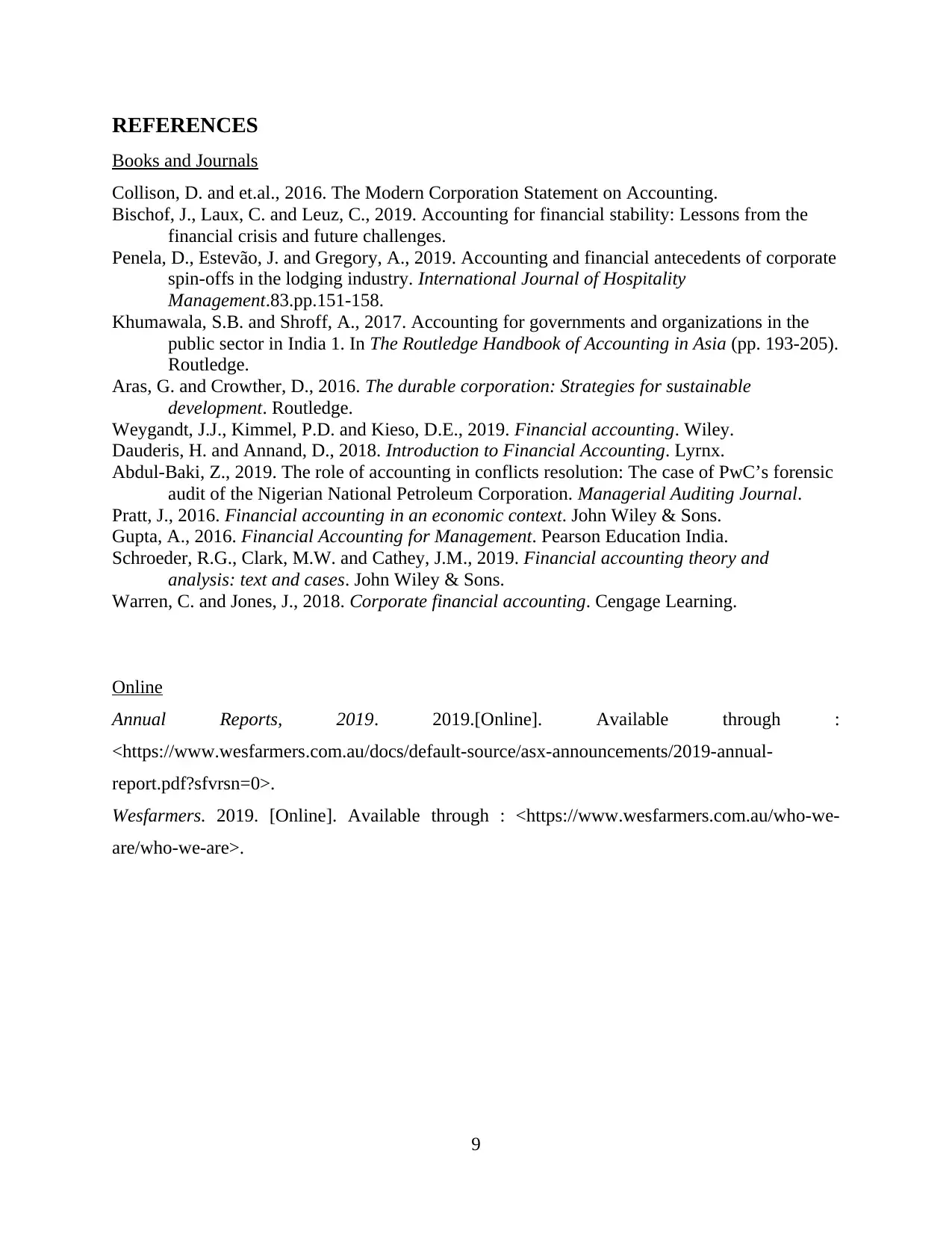
REFERENCES
Books and Journals
Collison, D. and et.al., 2016. The Modern Corporation Statement on Accounting.
Bischof, J., Laux, C. and Leuz, C., 2019. Accounting for financial stability: Lessons from the
financial crisis and future challenges.
Penela, D., Estevão, J. and Gregory, A., 2019. Accounting and financial antecedents of corporate
spin-offs in the lodging industry. International Journal of Hospitality
Management.83.pp.151-158.
Khumawala, S.B. and Shroff, A., 2017. Accounting for governments and organizations in the
public sector in India 1. In The Routledge Handbook of Accounting in Asia (pp. 193-205).
Routledge.
Aras, G. and Crowther, D., 2016. The durable corporation: Strategies for sustainable
development. Routledge.
Weygandt, J.J., Kimmel, P.D. and Kieso, D.E., 2019. Financial accounting. Wiley.
Dauderis, H. and Annand, D., 2018. Introduction to Financial Accounting. Lyrnx.
Abdul-Baki, Z., 2019. The role of accounting in conflicts resolution: The case of PwC’s forensic
audit of the Nigerian National Petroleum Corporation. Managerial Auditing Journal.
Pratt, J., 2016. Financial accounting in an economic context. John Wiley & Sons.
Gupta, A., 2016. Financial Accounting for Management. Pearson Education India.
Schroeder, R.G., Clark, M.W. and Cathey, J.M., 2019. Financial accounting theory and
analysis: text and cases. John Wiley & Sons.
Warren, C. and Jones, J., 2018. Corporate financial accounting. Cengage Learning.
Online
Annual Reports, 2019. 2019.[Online]. Available through :
<https://www.wesfarmers.com.au/docs/default-source/asx-announcements/2019-annual-
report.pdf?sfvrsn=0>.
Wesfarmers. 2019. [Online]. Available through : <https://www.wesfarmers.com.au/who-we-
are/who-we-are>.
9
Books and Journals
Collison, D. and et.al., 2016. The Modern Corporation Statement on Accounting.
Bischof, J., Laux, C. and Leuz, C., 2019. Accounting for financial stability: Lessons from the
financial crisis and future challenges.
Penela, D., Estevão, J. and Gregory, A., 2019. Accounting and financial antecedents of corporate
spin-offs in the lodging industry. International Journal of Hospitality
Management.83.pp.151-158.
Khumawala, S.B. and Shroff, A., 2017. Accounting for governments and organizations in the
public sector in India 1. In The Routledge Handbook of Accounting in Asia (pp. 193-205).
Routledge.
Aras, G. and Crowther, D., 2016. The durable corporation: Strategies for sustainable
development. Routledge.
Weygandt, J.J., Kimmel, P.D. and Kieso, D.E., 2019. Financial accounting. Wiley.
Dauderis, H. and Annand, D., 2018. Introduction to Financial Accounting. Lyrnx.
Abdul-Baki, Z., 2019. The role of accounting in conflicts resolution: The case of PwC’s forensic
audit of the Nigerian National Petroleum Corporation. Managerial Auditing Journal.
Pratt, J., 2016. Financial accounting in an economic context. John Wiley & Sons.
Gupta, A., 2016. Financial Accounting for Management. Pearson Education India.
Schroeder, R.G., Clark, M.W. and Cathey, J.M., 2019. Financial accounting theory and
analysis: text and cases. John Wiley & Sons.
Warren, C. and Jones, J., 2018. Corporate financial accounting. Cengage Learning.
Online
Annual Reports, 2019. 2019.[Online]. Available through :
<https://www.wesfarmers.com.au/docs/default-source/asx-announcements/2019-annual-
report.pdf?sfvrsn=0>.
Wesfarmers. 2019. [Online]. Available through : <https://www.wesfarmers.com.au/who-we-
are/who-we-are>.
9
1 out of 11
Related Documents
Your All-in-One AI-Powered Toolkit for Academic Success.
+13062052269
info@desklib.com
Available 24*7 on WhatsApp / Email
![[object Object]](/_next/static/media/star-bottom.7253800d.svg)
Unlock your academic potential
© 2024 | Zucol Services PVT LTD | All rights reserved.





